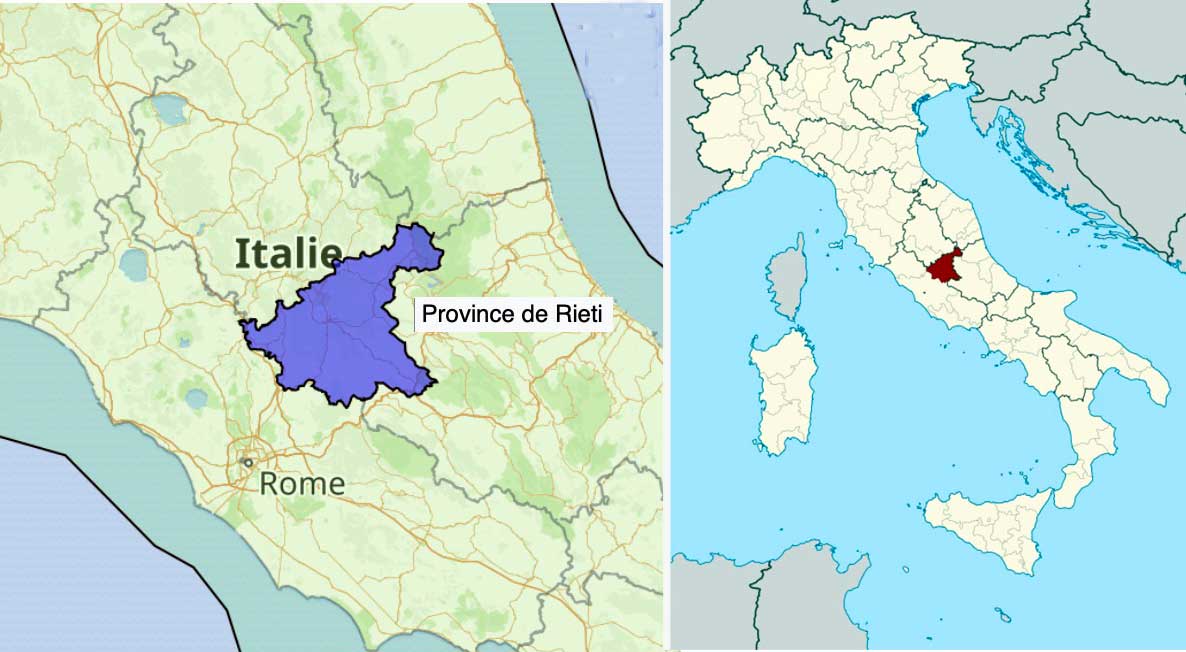Notes
Sabinie

La Sabine, en italien Sabina, est une région historique de l’Italie centrale qui tire son nom de l’ancien peuple des Sabins. Elle comprend les monts Sabins. La Sabine antique est de nos jours divisée en trois régions. Elle couvre, dans le Latium, l’entièreté de la province de Rieti et une portion de la province de Rome.
Aeneid Book 7
Ecce Sabinorum prisco de sanguine magnum
gmen agens Clausus magnique ipse agminis instar,
Claudia nunc a quo diffunditur et tribus et gens
per Latium, postquam in partem data Roma Sabinis.
una ingens Amiterna cohors priscique Quirites,
Ereti manus omnis oliviferaeque Mutuscae;
qui Nomentum urbem, qui Rosea rura Velini,
qui Tetricae horrentis rupes montemque Severum
Casperiamque colunt Forulosque et flumen Himellae
qui Tiberim Fabarimque bibunt, quos frigida misit
Nursia, et Ortinae classes populique Latini…
See! Clausus [28] of the ancient Sabine blood, leading a mighty host, and equal to a mighty host himself; from whom now through Latium spreads the Claudian tribe and clan, since Rome was shared with the Sabines. With him came Amiternum’s vast cohort, and the ancient Quirites, the whole band of Eretum and olive-bearing Mutusca; those who dwell in Nomentum’s city and the Rosean country by Velinus, on Tetrica’s rugged crags and Mount Severus, in Casperia and Foruli, and by Himella’s stream; those who drink of Tiber and Fabaris, those whom cold Nursia sent, the Ortine squadrons, the Latin peoples….
28. Cf. Livy 2.16, where we learn that the Claudian tribe was founded by Attus Clausus, who seceded from the Sabines in 506 b.c. and was received as a citizen in Rome. Virgil, however, re fers the founding of the Claudian gensto the earlier day when Romulus formed a treaty with the Sabines under Titus Tatius.
Sabinie
quod ad proceritatem quidem attinet, Rosea agri Sabini arborum altitudinem aequat.
As regards height, the hemp of Rosea in the Sabine territory grows as tall as a fruit-tree.
Sabinie
Reliqua sunt ferulacei generis, ceu feniculum anguibus, ut diximus, gratissimum, ad condienda plurima cum inaruit utile, eique perquam similis thapsia, de qua diximus inter externos frutices, deinde utilissima funibus cannabis. seritur a favonio; quo densior est eo tenerior. semen eius, cum est maturum, ab aequinoctio autumni destringitur et sole aut vento aut fumo siccatur. ipsa cannabis vellitur post vindemiam ac lucubrationibus decorticata purgatur. optima Alabandica, plagarum praecipue usibus. tria eius ibi genera: inprobatur cortici proximum aut medullae, laudatissima est e medio quae mesa vocatur. secunda Mylasea. quod ad proceritatem quidem attinet, Rosea agri Sabini arborum altitudinem aequat. ferulae duo genera in peregrinis fruticibus diximus. semen eius in Italia cibus est; conditur quippe duratque in urceis vel anni spatio. duo ex ea olera, caules et racemi. corymbian hanc vocant corymbosque quos condunt.
There remain the garden plants of the fennel-giant class, for instance fennel, which snakes are very fond of, as we have said, and which when dried is useful for seasoning a great many dishes, and thapsia, which closely resembles it, of which we have spoken among foreign bushes, and then hemp, which is exceedingly useful for ropes. Hemp is sown when the spring west wind sets in; the closer it grows the thinner its stalks are. Its seed when ripe is stripped off after the autumn equinox and dried in the sun or wind or by the smoke of a fire. The hemp plant itself is plucked after the vintage, and peeling and cleaning it is a task done by candle light. The best is that of Arab-Hissar, which is specially used for making hunting-nets. Three classes of hemp are produced at that place: that nearest to the bark or the pith is considered of inferior value, while that from the middle, the Greek name for which is ‘middles’, is most highly esteemed. The second best hemp comes from Mylasa. As regards height, the hemp of Rosea in the Sabine territory grows as tall as a fruit-tree. The two kinds of fennel-giant have been mentioned above among exotic shrubs. In Italy its seed is an article of diet; in fact it is stored in pots and lasts for as much as a year. Two different parts of it are used as vegetables, the stalks and the branches. This fennel is called in Greek clump-fennel, and the parts that are stored, clumps.
Sabinie
p. 254 Sabinie] Voiez Pline, l. 19. chap. 9
Sabinie
Sabinia. See Pliny l. 9 c. 9.
Rosea near Praeneste in the Sabine territory
Cf. Pliny xix 9: “Quod ad proceritatem quidem attinet Rosea agri Sabini arborum altitudinem aequat.”
Sabinie
D’apres Pline, XIX, 56.
Sabine
Sabine. [adaptation of Latin Sabinus]
Of or pertaining to the Sabines:
1600 Philemon Holland, translator tr. Livy’s Romane Hist. i. 8 And the youth of Rome upon a token and watch-word given, fell on every side to carrie away the Sabine maidens.
1606 Jonson Hymenaei sig. Cv, The Speare, which (in the Sabine tongue) was called Curis.
1697 Dryden Æneid viii. 842 Sabine dames.
1756 C. Smart tr. Horace, Satires i. ix. (1826) II. 75 An old Sabine sorceress.
One of a race of ancient Italy who inhabited the central region of the Apennines.
1387 John de Trevisa Higden (Rolls) III. 61 Tacius kyng of Sabyns was i-slawe by assent of Romulus.
1533 Bellenden Livy i. iv. (S.T.S.) I. 29 Ane huge nowmer of Sabinis with þare wyiffis, barnis, & servandis.
1601 Philemon Holland, translator Pliny’s History of the world, commonly called the Natural historie I. 65 The Sabines… dwell hard by the Veline lakes.
1783 W. Gordon tr. Livy’s Rom. Hist. (1823) I. xxxviii. 70 The Sabines fled to the Mountains.
Transferred sense in allusion to the proverb Sabini quod volunt somniant, `the Sabines dream what they will’ (Festus).
1610 Philomen Holland, translator Camden’s Brit. 542 Grimsby, which our Sabins, or conceited persons dreaming what they list, and following their owne fansies, will have to be so called of one Grime a merchant.